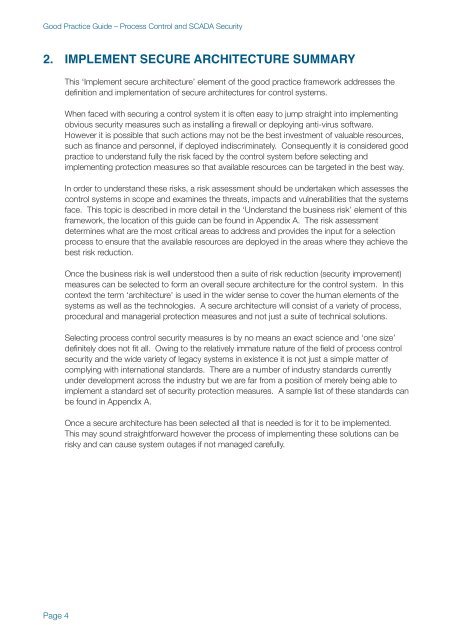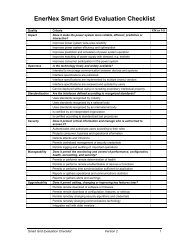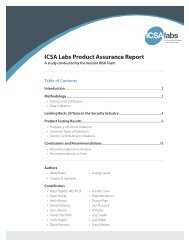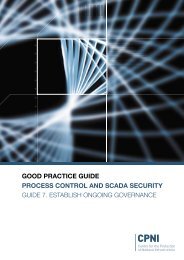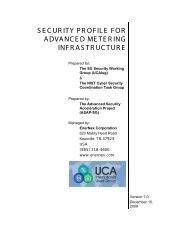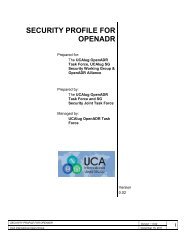CPNI - GPG - Guide 2 - Implement Secure Architecture
CPNI - GPG - Guide 2 - Implement Secure Architecture
CPNI - GPG - Guide 2 - Implement Secure Architecture
You also want an ePaper? Increase the reach of your titles
YUMPU automatically turns print PDFs into web optimized ePapers that Google loves.
Good Practice <strong>Guide</strong> – Process Control and SCADA Security<br />
2. IMPLEMENT SECURE ARCHITECTURE SUMMARY<br />
This ‘<strong>Implement</strong> secure architecture’ element of the good practice framework addresses the<br />
definition and implementation of secure architectures for control systems.<br />
When faced with securing a control system it is often easy to jump straight into implementing<br />
obvious security measures such as installing a firewall or deploying anti-virus software.<br />
However it is possible that such actions may not be the best investment of valuable resources,<br />
such as finance and personnel, if deployed indiscriminately. Consequently it is considered good<br />
practice to understand fully the risk faced by the control system before selecting and<br />
implementing protection measures so that available resources can be targeted in the best way.<br />
In order to understand these risks, a risk assessment should be undertaken which assesses the<br />
control systems in scope and examines the threats, impacts and vulnerabilities that the systems<br />
face. This topic is described in more detail in the ‘Understand the business risk’ element of this<br />
framework, the location of this guide can be found in Appendix A. The risk assessment<br />
determines what are the most critical areas to address and provides the input for a selection<br />
process to ensure that the available resources are deployed in the areas where they achieve the<br />
best risk reduction.<br />
Once the business risk is well understood then a suite of risk reduction (security improvement)<br />
measures can be selected to form an overall secure architecture for the control system. In this<br />
context the term ‘architecture’ is used in the wider sense to cover the human elements of the<br />
systems as well as the technologies. A secure architecture will consist of a variety of process,<br />
procedural and managerial protection measures and not just a suite of technical solutions.<br />
Selecting process control security measures is by no means an exact science and ‘one size’<br />
definitely does not fit all. Owing to the relatively immature nature of the field of process control<br />
security and the wide variety of legacy systems in existence it is not just a simple matter of<br />
complying with international standards. There are a number of industry standards currently<br />
under development across the industry but we are far from a position of merely being able to<br />
implement a standard set of security protection measures. A sample list of these standards can<br />
be found in Appendix A.<br />
Once a secure architecture has been selected all that is needed is for it to be implemented.<br />
This may sound straightforward however the process of implementing these solutions can be<br />
risky and can cause system outages if not managed carefully.<br />
Page 4


